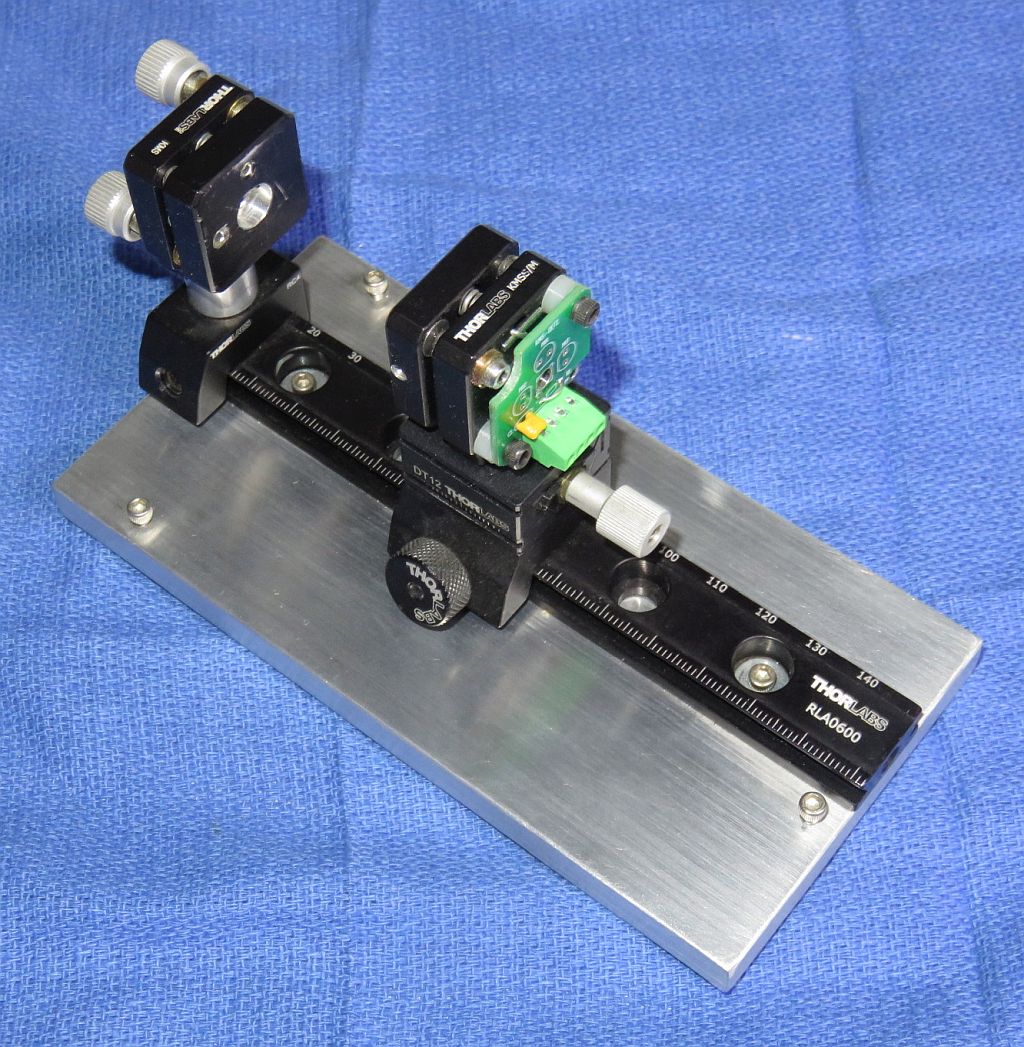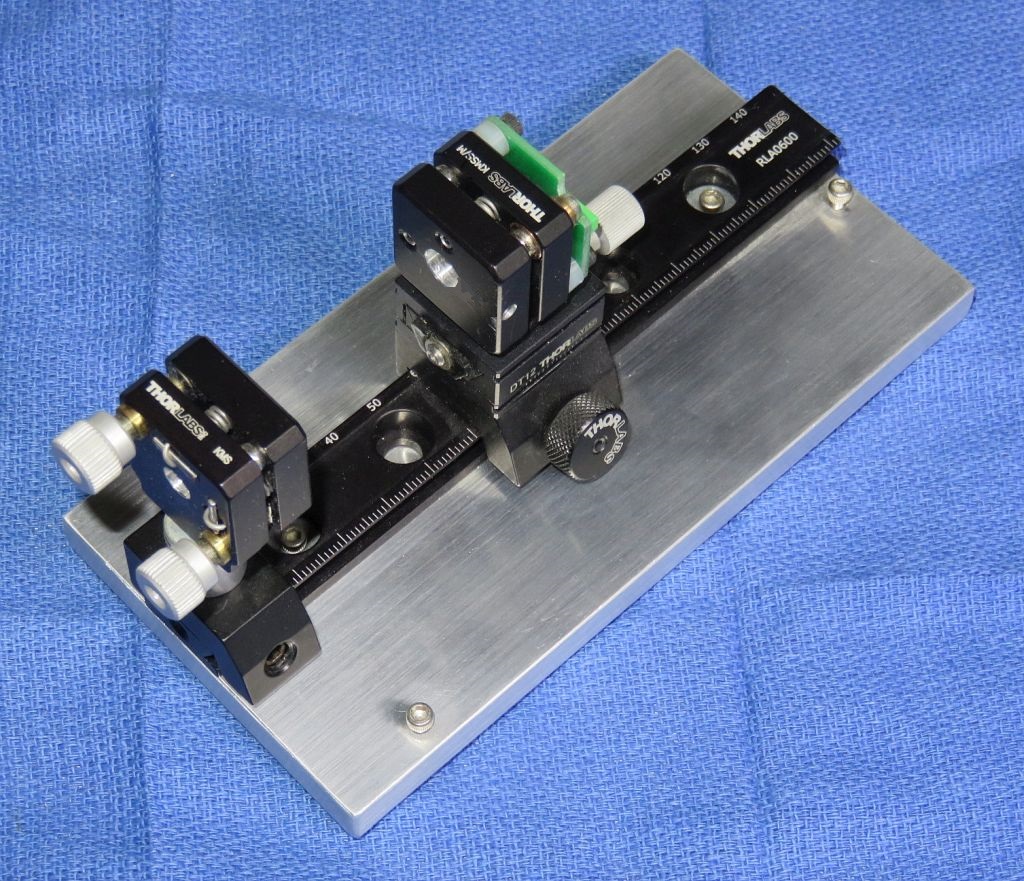These are kits
of parts to construct several different types of Scanning Fabry-Perot
Interferometers (also may be used as laser spectrum analyzers, tunable
etalons, or tunable optical frequency filters). The usable wavelengths
extend somewhat beyond the limits listed but how far cannot be
guaranteed.
(The Michelson interferometer kits have moved to their own listing: 303925810399.)
THIS LISTING has replaced my other listings: "One Stop Shopping" for DIY SFPI kits now including versions for Red, Orange, Yellow, Green, Blue, and Violet
wavelengths. ;-) Shipping is usually same day for non-Deluxe kits but may be up to 5 days if parts need to be ordered.
Sorry, nothing much beyond 700 nm. I thought I had a supplier but the mirrors turned out to not be usable for an SFPI.
Not all the options in this listing are shown in the main photo.
Versions of these SFPI kits are also available using any of the
broadband or other mirrors in listing #303503394501. Inquire if
interested.
Sorry, no short cavity spherical mirror SFPI kits for wavelengths below
590 nm are currently available. And, there are only planar mirror SFPI kits for wavelengths above 650 nm, and none beyond 1,100 nm.
And mirrors for the GY 525-600 nm are out of stock. However, substitutes with a 1 m RoC and acceptable reflectance may be available, but the usable area is only 3 or 4 mm in diameter. Inquire if interested.
Types 1-8 SFPI YOR
(Yellow-Orange-Red) can be used to construct general purpose Laser
Spectrum Analyzers (LSAs) for displaying the complete set of
longitudinal modes of YOR
590-650 nm HeNe lasers. Types 1 or 2 are probably what you really want
since these are most useful for general purpose use and have
capabilities similar to those of common commercial SFPIs covering the
same wavelengths. They are also the same kits as offered in the
separate SFPI listings I used to have. The others are for specialized
SFPI nerd applications and may be far more challenging to construct and get
working as well. :-)
There are now a few complete Mini
Laser Mode Analyzer (mLMA1) kits available.
However, mLMA1 is really intended for
short SFPIs like Types 1-8 SFPI YOR - performance with the other SFPIs may be unsatisfactory. Regardless of SFPI type, a real function
(ramp) generator and oscilloscope are highly recommended for initial
setup at least. Inquire for more details or go to the mLMA1 Web page.
All mirrors are new/NOS. They are 7.75 mm diameter except as noted.
Note:
All selections must have valid entries for the correct price to appear.
If the behavior is not as expected, please contact me. Creating these
multi-option listings is a bit dicey and even after many years, eBay
has not fixed some significant bugs. And sorry, I have no control over
what default price appears in the listing. :-) Note that if an entry is
grayed out for a particular selection, it usually means the option
doesn't apply as it would not work well or at all with the selected
mirror set and/or resonator length, is NOT available, or I forgot to
update the available quantity. Inquire if interested.
Spherical Mirror SFPI Kits:
Spherical
mirror SFPIs are the most common type for general purpose use as they
are easy to align and it's usually possible to avoid back-reflection
into the laser by careful alignment with the beam slightly off-axis.
However, for any given set of mirrors, they have a limited set of mirror
spacings which may be used and thus only a few options for FSRs. The
most common is called "confocal" with a cavity spacing equal to the RoCs
of the mirrors, but others may have benefits either in terms of space
or FSR. The non-Deluxe kits include a pair of mirrors, PZT with center hole, and photodiode only. Mounting is left to your imagination, creativity, and budget.
The Deluxe and Deluxe+ kits add combinations of Thorlabs cage parts to
construct an SFPI frame. There may be other parts included in specific
cases - check the detailed descriptions below.
- Long
radius mirrors may also be used with shorter frames using higher orders
of N. See #23 below and the description of mode degenerate SFPIs.
Inquire for more information.
- Note
that the "+" option which substitutes an adjustable mount for one of
the cage plates in some of the Deluxe spherical SFPIs is not really
required for those using the 42 mm RoC mirrors. With care in centering
of the mirrors during assembly, they will work just fine using only the
entire frame for alignment. Thus this option may be grayed out - if you
really want the adjustable mount, ask me to enable it. ;-)
- And you'll still get friendly tech support even if you buy parts directly from Thorlabs or elsewhere. ;-)
Available Spherical Mirror SFPI Kits using 42 mm RoC Mirrors:
- Basic SFPI YOR 590-650 nm:
~4.2 cm RoC mirrors with PZT and photodiode ONLY. Covers popular
Yellow through Red wavelengths. Confocal FSR of ~1.79 GHz. Finesse at
633 nm: > 200, at 594 nm: typically > 100. Measured reflectance
of a sample of the mirrors: 99.6%@594 nm, 99.7%@605 nm, 99.8%@612 nm,
99.8%@633 nm. More below. The diagram of the SFPI assembly is a
serving suggestion built using scrap metal and common hardware
(additional parts not included). The scope display shows the modes of a
5 mW 633 nm HeNe laser using the mirrors in this kit and either an SFPI
assembly similar to the one in the diagram, or the deluxe verson below.
(For anyone who has been paying attention, the RoC used to be 4.3 cm,
but it has been measured for one pair of mirrors more accurately using a
selectable FSR SFPI by recording the exact locations of the first few
mode-degenerate spacings.)
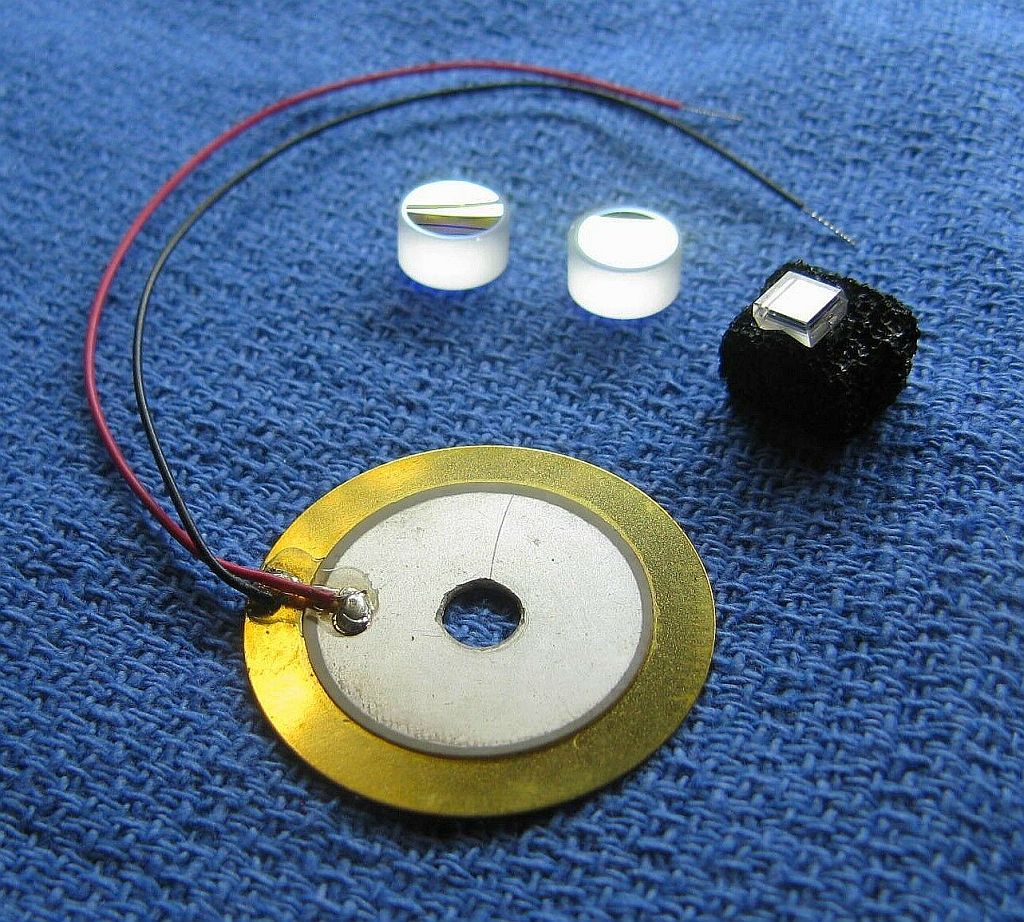
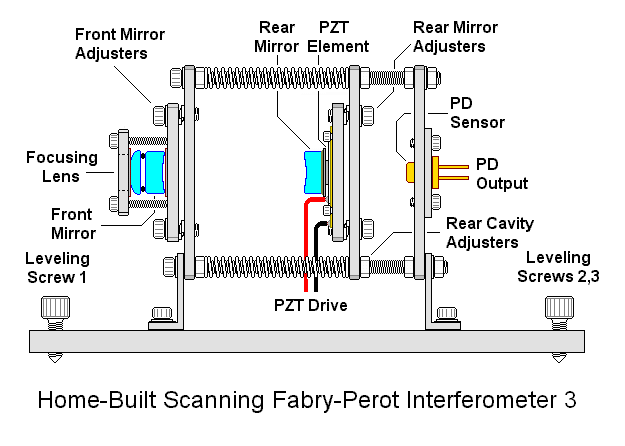
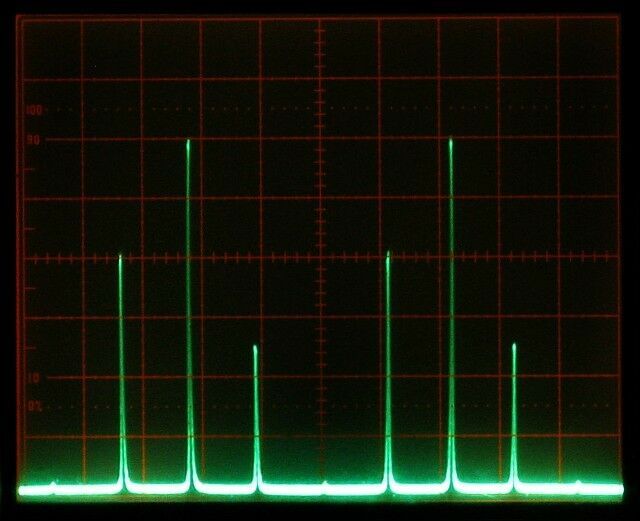
- Deluxe SFPI YOR 590-650 nm:
Basic SFPI parts PLUS a 4 inch long frame using Thorlabs 30 mm cage
components and focusing lens. The photo on the right shows a complete
SFPI head mounted on an adjustable metal base (not included).
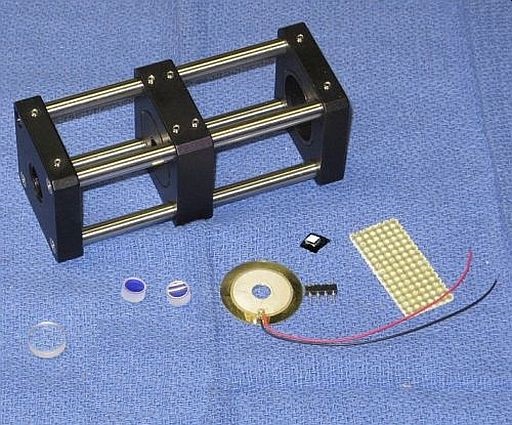
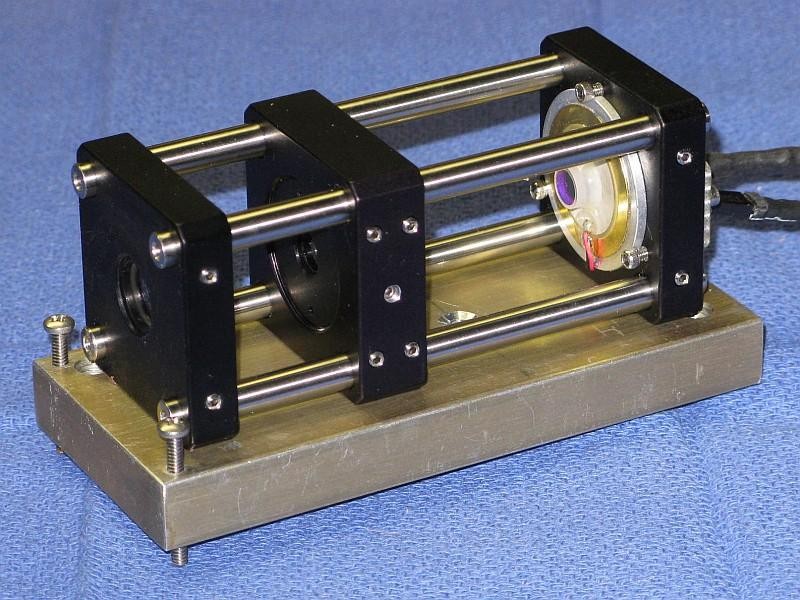
- Deluxe+ SFPI YOR 590-650 nm:
Replaces one of the cage plates in the Deluxe kit with an adjustable
mount. This may make your life easier though it is not really needed as
noted above.
- Deluxe Short SFPI YOR 590-650 nm:
Similar to Deluxe SFPI parts but with a 3 inch long frame using
Thorlabs 30 mm cage components and focusing lens. 1/2 Confocal spacing
recommended, FSR of 2.38 GHz. Finesse at 633 nm: > 133; finesse at
594 nm > 65.
- Deluxe Mini-SFPI YOR 590-650 nm:
Basic SFPI parts except for ~20 mm instead of 27 mm PZT, PLUS a 2 inch
long frame using Thorlabs 16 mm cage components and focusing lens. 1/2
Confocal spacing recommended, FSR of 2.38 GHz. Finesse at 633 nm: >
133; finesse at 594 nm > 65. This head is really compact and cute.
;-) The second photo shows a completed head also including a dual
polarization beam sampler in front for the mode display of mLMA1 (not
included).
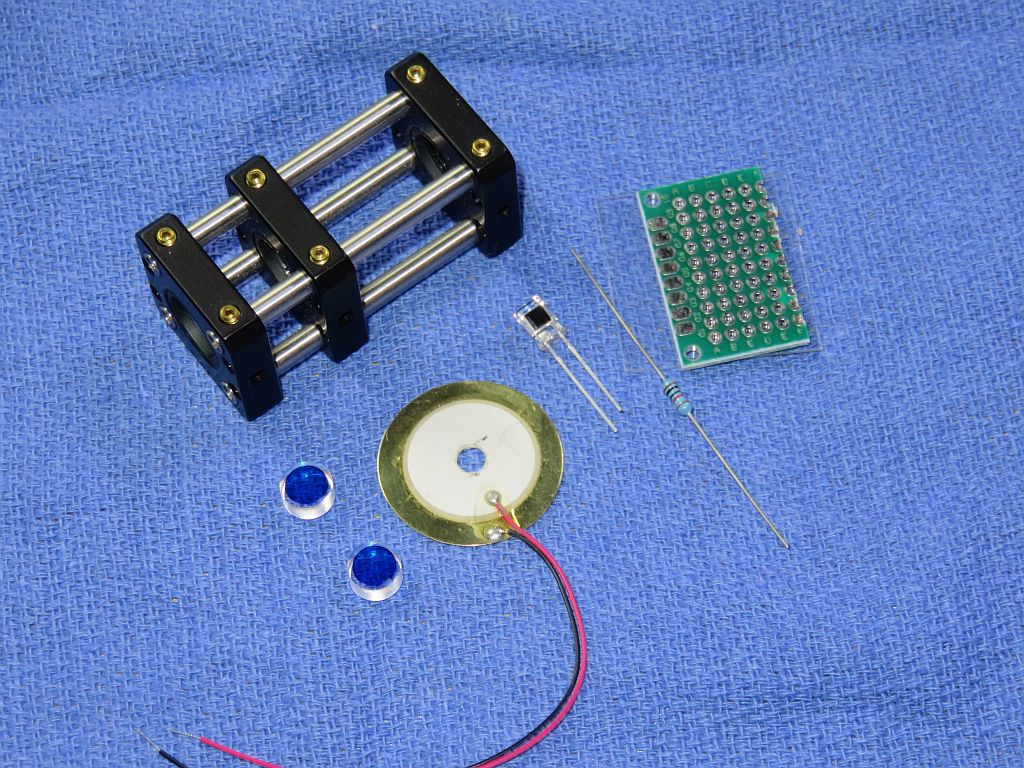
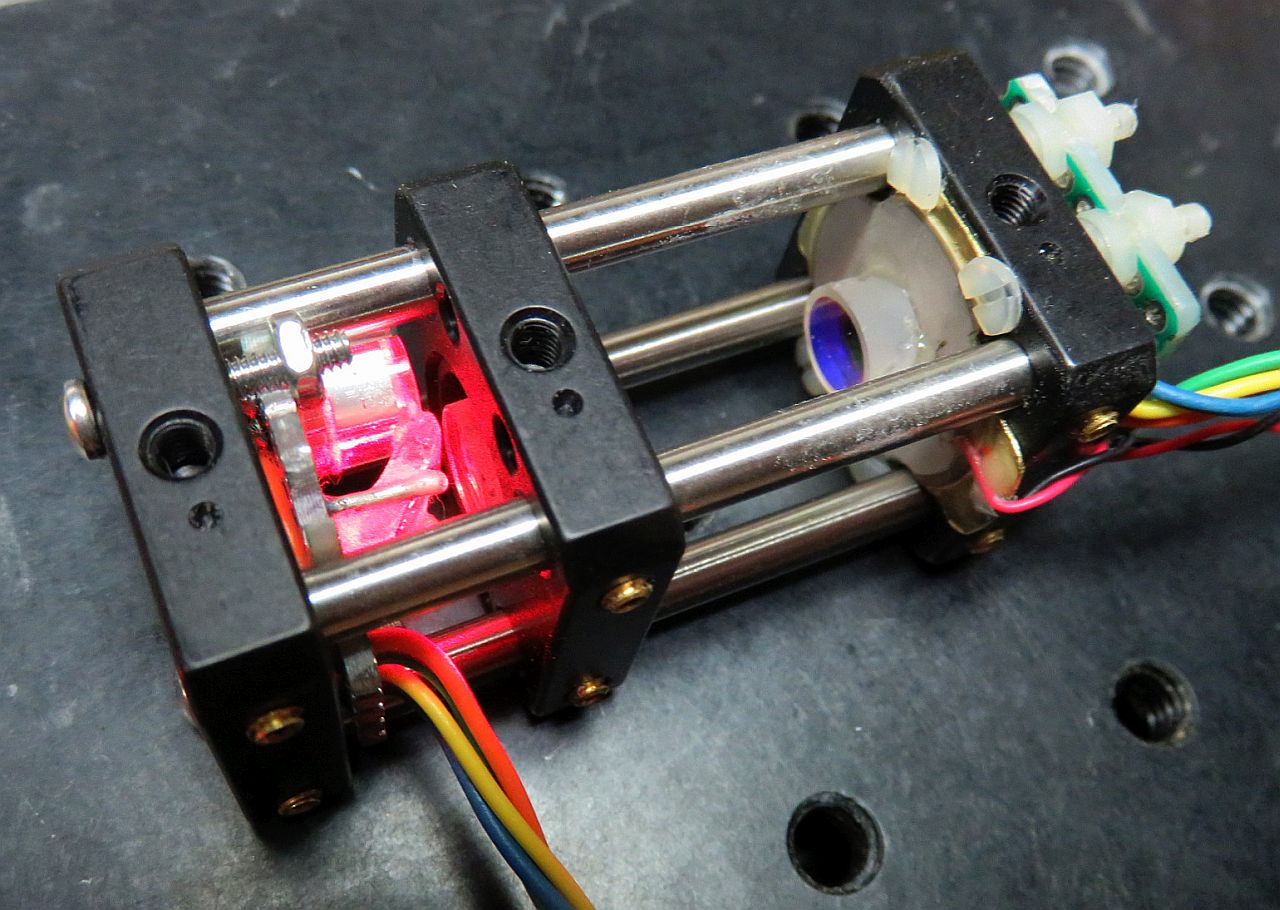
- Deluxe+ Mini-SFPI YOR 590-650 nm: Replaces one of the cage plates in the Deluxe kit with an adjustable mount. Even less important. :)
- Deluxe Micro-SFPI YOR 590-650 nm: Similar to Deluxe Mini-SFPI YOR
590-650 nm but with 1.5 inch long frame and ~20 mm diameter PZT. Must
use cavity parameter N of 3 or greater. Finesse should still be way
more than high enough for use with mLMA1. For N=3 (no space for lens
mount), cavity length = ~2.1 cm, FSR of ~2.4 GHz, finesse >100. For
N=4, cavity length = ~1.23 cm, FSR of ~3.05 GHz, finesse >65.
- Deluxe Nano-SFPI YOR 590-650 nm: Similar to Deluxe Micro-SFPI YOR
590-650 nm but with ~1x1x1 inch frame and no lens or mount. Must use
cavity parameter N of 4 or greater. The display is of the same Melles
Griot 05-LHR-151 ~5 mW HeNe. For N=4, cavity length = ~1.23 cm, FSR of
~3.05 GHz, finesse >65. The Finesse is still high enough for use
with mLMA1. Super compact and cute. ;-)
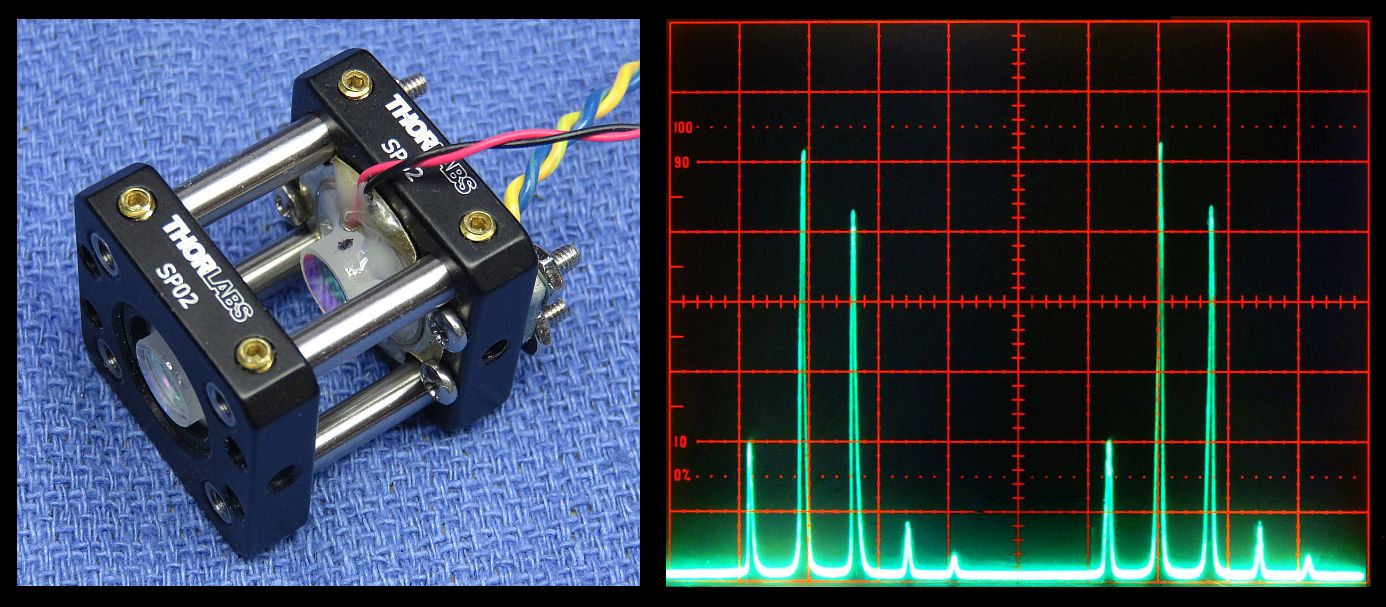 - Selectable FSR SFPI YOR 590-650 nm: This
setup permits the cavity spacing to be easily changed and then fine
tuned to experiment with almost any usable mode degenerate spacing shown
in the table below, and more. It consists of a Thorlabs 6 inch rail
with two platforms on a baseplate for coarse positioning, small linear
stage for fine positioning, mirror mounts, the same mirrors as in the
Basic SFPI YOR 590-650 nm,
PZT and photodiodes with custom PCB for mounting. There is also a
version with a ball bearing rail instead. See "Construction Guidelines
for the Selectable FSR Scanning Fabry-Perot Interferometer Kit 1".
Google will find it. Longer
versions may be available eventually. Note: If you will only be using
the SFPI at a fixed spacing, the setups using Thorlabs cage parts are
probably more stable. The benefit with this one is ease of cavity
length adjustment. Diagram on left, photos of prototype before adding mirrors, PZT, and detectors on right. Note: I am no longer offering complete kits for this, but may have sets of parts where some like the baseplate may not be finished. These would be at a somewhat lower cost. Ask.
Available Spherical Mirror SFPI Kits using Longer Radius Mirrors:- Mid SFPI parts for YOR 590-650 nm:
13.6 cm RoC mirrors with PZT and photodiode ONLY. Confocal FSR of ~551
MHz, R 98-99% at 633 nm, finesse from 75 to 150. R > 97% 594-650
nm. The diameter of the mirrors is approximately 10 mm but only the
central 4 mm or so is coated.
- Deluxe Mid SFPI parts for YOR 590-650 nm: This adds an 8 inch long frame using Thorlabs 30 mm cage components, adjustable mount at one end.
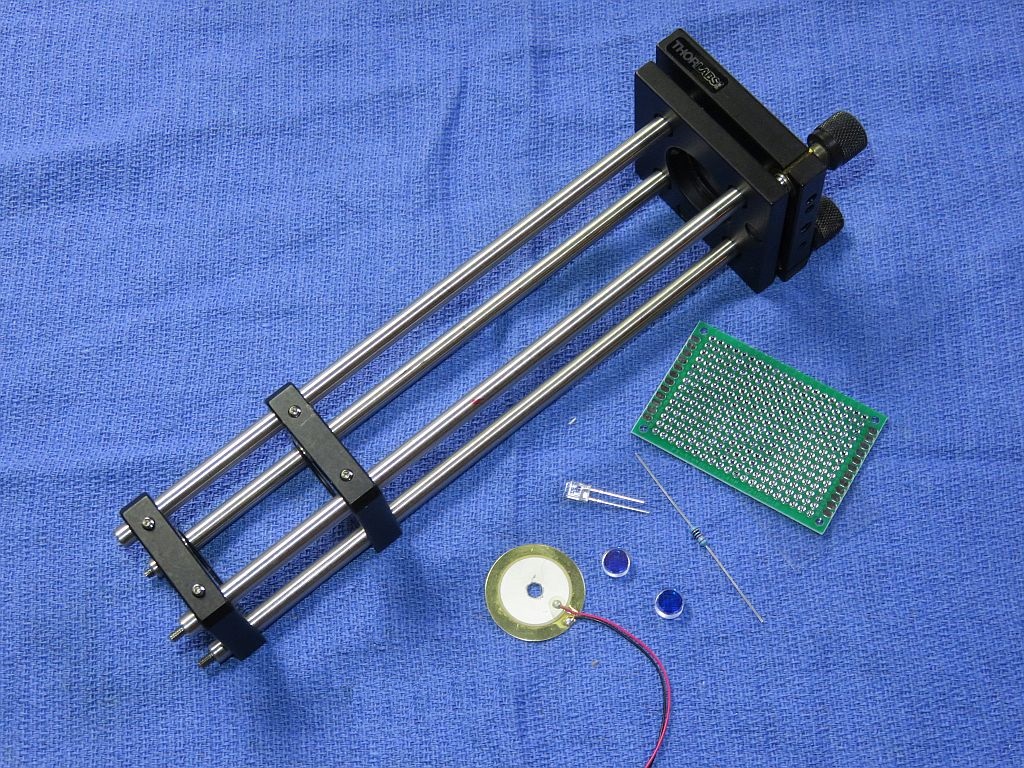
- Long SFPI parts for YOR 590-650 nm:
30 cm RoC mirrors with PZT and photodiode ONLY. Confocal FSR of 250
MHz. Finesse at 633 nm > 100. Measured reflectance of a sample of
the mirrors: 95.7%@594 nm, 97.6%@605 nm, 98.2%@612 nm, 98.8%@633 nm. So
this would still be useful for determining SLM behavior over the YOR
wavelength range and the generally lower reflectance makes setting up
aligning simpler. At 544 nm, R is around 40%; above 633 nm, R has not
been measured but it may be higher over some range.
- Deluxe Long SFPI parts for YOR 590-650 nm: This adds a 14 inch long frame using Thorlabs 30 mm cage components, adjustable mount at one end.
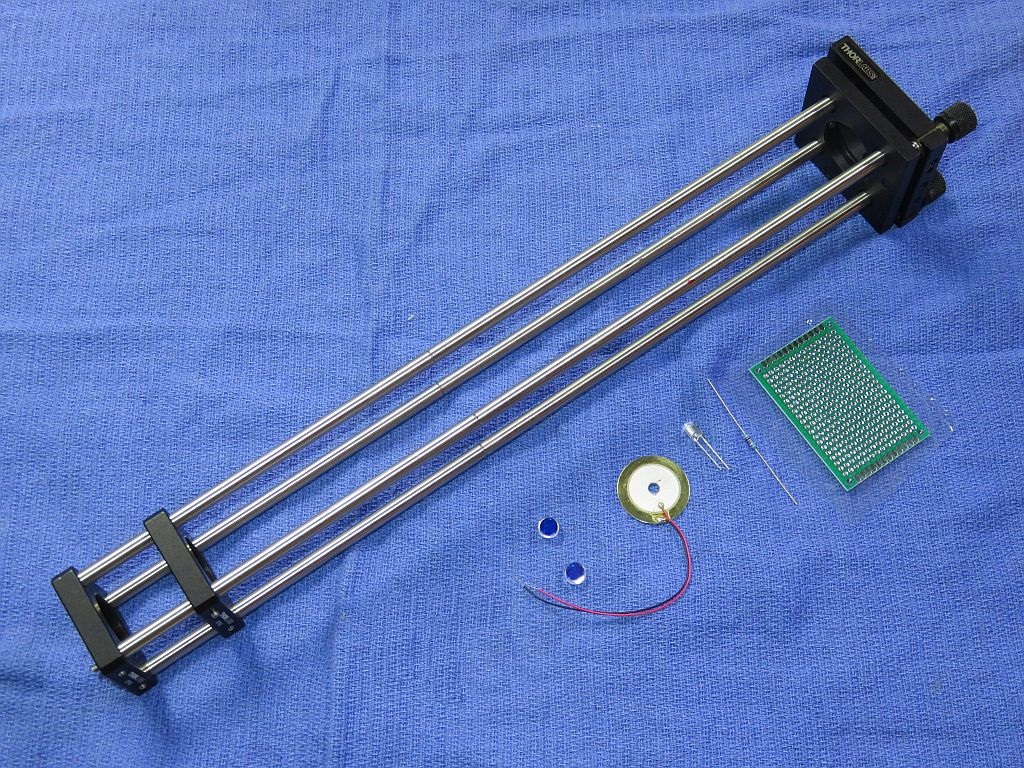
- High Resolution SFPI YOR 590-650 nm:
100 cm RoC mirrors with PZT and photodiode ONLY. Confocal FSR of 75
MHz. Finesse at 633-594 nm: > 200. Measured reflectance of a sample
of the mirrors: >99.8%@594 nm, 99.8%@605 nm, 99.8%@612 nm, 99.4@%633
nm. Should be acceptable for some range beyond 650 nm but how far has
not been tested.
- Deluxe High Resolution SFPI YOR 590-650 nm:
This adds a 14 inch long frame using Thorlabs 30 mm cage components,
adjustable mount at one end similar to those for the Long SFPI, above,
and below. (The adjustable baseplates, and iris diaphragm at the front
are NOT included but are available, see the options below.) When set to
a mirror spacing of around 29 cm (N/k=4/1 in the chart below), the
result should be an effective FSR of around 129 MHz with a finesse of
more than 200 for 633 nm and probably somewhat higher for 594 nm. This
will easily resolve the split modes of most high-field regime axial
Zeeman lasers like those from HP/Agilent including all 5517s, 5518A,
5519A/B, 5501B, and N1211A as shown in the last photo and below. The
split frequency is around 1.5 MHz. There is no affordable commercial
instrument with this high performance.

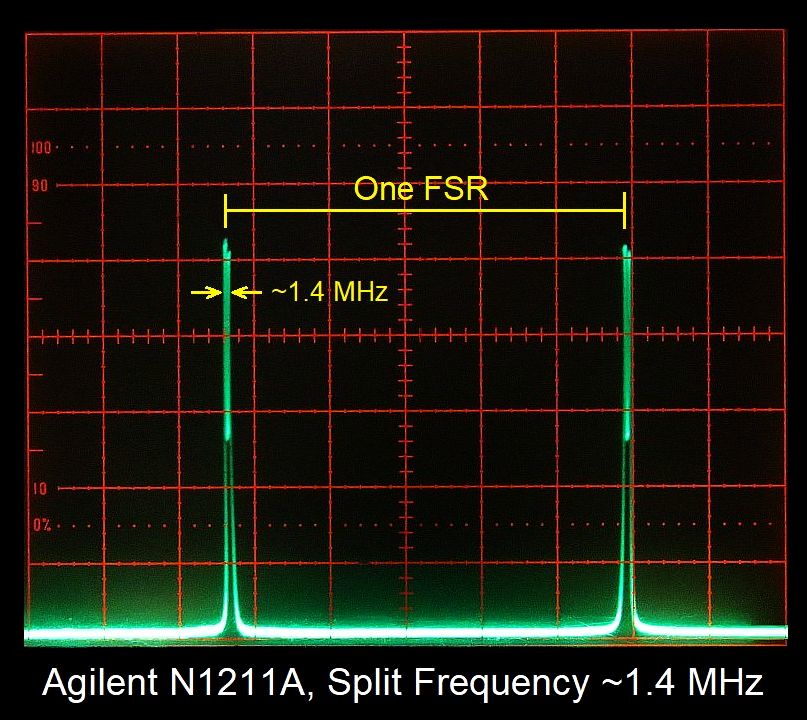
- Deluxe+ High Resolution SFPI YOR 590-650 nm: This adds a set of 8 inch cage rods to extend the frame to 22 inches so the cavity length may include
the half-confocal spacing (your choice but you must specify in a
message, or else it will be my choice). (The iris diaphragm and bars
with adjustment screws are NOT included.) With a mirror spacing of
around 50 cm, the resolution should be better than 500 kHz.

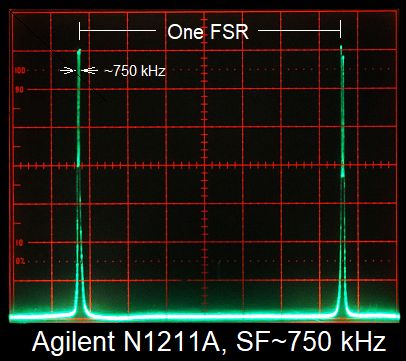
- Ultra-High Resolution SFPI YOR 590-650 nm:
Hi-Q 99.99+% HR 60 cm RoC mirrors with PZT and photodiode ONLY.
Half-Confocal FSR of ~167 MHz. Finesse at 633 nm: is at least 1,500 and
may be much more with a mode-matched input. Measured reflectance of a
sample of the mirrors: >99.993%@633 nm and appears to be similar at
594 and 612 nm but not precisely measured. The only reason to want to
build one of these is to have bragging rights to the highest finesse
SFPI on your block. ;-)
- Deluxe Ultra-High Resolution SFPI YOR 590-650 nm:
This adds a 14 inch long frame using Thorlabs 30 mm cage components,
adjustable mounts at both ends with the front one on a translation stage
(styles may vary). (The iris diaphragm at the front is not included
but the front and back height adjustment plates and some other
odds-and-ends will be included. An iris is available, see the options
below.) The resolution using the exact rig below is better than 50 kHz.
The screen shots show the display of a single frequency
Spectra-Physics 117A laser and the split modes of an Agilent N1211A two
frequency laser separated by 520 kHz. And it only requires around 37
hours of fiddly alignment in a pitch black room. :) And if you're a
real masochist, extend the frame to 26 inches for the full confocal
spacing and nearly double the resolution. Better have a sleeping bag
and snacks handy. ;-)

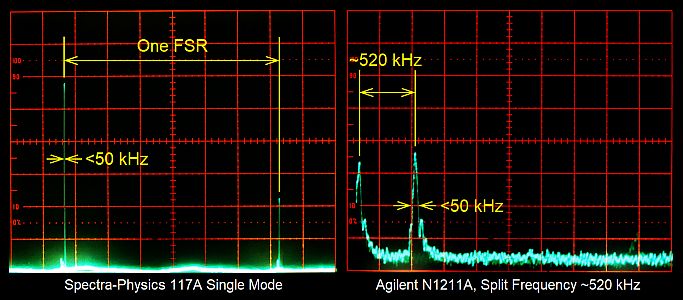
- Universal SFPI YOR 590-650 nm:
This consists of pairs of 7.75 mm diameter 4.2 cm RoC and 100 cm RoC
99.5% mirrors and a pair of 60 cm RoC 99.99+% mirrors, 3 holey PZTs, and
associated photodiodes, along with cage rods to construct a frame from
2 to 24 inches in length, adjustable mounts, translation stage, iris,
cage plates, adapters, and most other hardware to construct nearly all
of the SFPIs above and more. This is the ultimate kit for the SFPI
junkie in your life who would love to spend several months or more
playing with mirrors. "It's all done with mirrors." ;-)
- High Resolution SFPI GY 525-600 nm:
100 cm RoC mirrors with PZT and photodiode ONLY. Covers popular Green
through Yellow wavelengths. Confocal FSR of 75 MHz. Finesse at 532 and
544 nm: >200. Measured reflectance of a sample of the mirrors:
95%@488nm, 99.7%@514 nm, 99.8%@544 nm, 99.5%@594 nm. So good down to
514 nm at least.
- Deluxe High Resolution SFPI GY 525-600 nm:
This adds a 14 inch long frame using Thorlabs 30 mm cage components,
adjustable mount at one end like the Deluxe High Resolution SFPI YOR
590-650 nm, above. When set to a mirror spacing of around 29 cm
(N/k=4/1 in the chart below), the result should be an effective FSR of
around 128 MHz with a finesse of 150 or more from 530-610 nm.
- Deluxe+ High Resolution SFPI GY 525-600 nm: This adds a set of 8 inch cage rods to extend the frame to 22 inches so the cavity length may include
the half-confocal spacing (your choice but you must specify in a
message, or else it will be my choice).
- Deluxe+ High-N SFPI GY 525-600 nm: This has the same frame as the Deluxe+ SFPI YO
R 590-650 nm (including an adjustable mount at one end) but with the GY 525-600 nm mirrors, so
it must be used with an "N" value of 9, 10, or above. (See below for
an explanation.) At a spacing of 4.9 cm (N=10), the FSR will be 306.3
MHz and the finesse should be at least 50, possibly over 100 with
careful alignment and very clean mirrors. This doesn't compare to a
high resolution SFPI but would be more than sufficient to monitor a
green or yellow laser for single frequency/single longitudinal mode
(SF/SLM) operation. However alignment is definitely more critical than
for the short confocal SFPI and back-reflections into the laser aperture may be unavoidable. Other frame lengths may be available. The screen shot below shows a test with a Coherent 215M 532 nm SLM laser.

- High Resolution SFPI BG 488-550 nm:
140 cm RoC mirrors with PZT and photodiode ONLY. Covers popular Blue
through Green wavelengths. Confocal FSR of 54 MHz. Finesse at 532 and
544 nm: >200. Measured reflectance of a sample of the mirrors:
99.5%@544 nm. Spec'd reflectance at 488 nm: 96.5%. Probably good for
somewhat beyond 544 nm but NOT much below 488 nm or to 594 nm. There is
at least one set with much higher R at 488 nm: 99-99.7%. Inquire if
interested. LO1207.
- Deluxe High Resolution SFPI BG 488-550 nm:
This adds a 22 inch to 24 inch long frame using Thorlabs 30 mm cage components,
adjustable mount at one end like the Deluxe+ High Resolution SFPI YOR
590-650 nm, above. When set to a mirror spacing of around 41 cm
(N/k=4/1 in the chart below), the result should be an effective FSR of
around 92 MHz. LO1207.
- Long SFPI B1 450-520 nm:
60 cm RoC mirrors with PZT and photodiode ONLY. Covers popular Blue
argon ion and DPSS wavelengths. Confocal FSR of 125 MHz. Measured
reflectance of a sample of these mirrors: ~98.5%@458 nm, 97%@488 nm,
~98%@514 nm. Finesse at 458 nm: > 60. With a spacing of 30 cm,
finesse at 458 nm (N/k=3/1 in the chart below): >30. FSR ~170 MHz.
- Deluxe Long SFPI B1 450-520 nm:
This adds an 14 inch long frame using Thorlabs 30 mm cage components,
adjustable mount at one end. (Same frame as the Deluxe Long SFPI,
above.)
- Long SFPI B2 458+514 nm: 30
cm RoC mirrors with PZT and photodiode ONLY. Dual Blue 458 and 514 nm
argon wavelengths, good at Blue 457 nm DPSS. Confocal FSR of 250 MHz.
Measured reflectance of a sample of these mirrors: >99%@458,
>97%@514 nm, but much lower in between. Finesse at 458 nm > 200,
at 514 nm > 30. With a spacing of 15 cm, finesse at 458 nm: >
100, at 514 nm >15. Confocal FSR of ~340 MHz.
- Deluxe Long SFPI B2 458+514 nm:
This adds a 14 inch long frame using Thorlabs 30 mm cage components,
adjustable mount at one end. (Same frame as the Deluxe Long SFPI,
above.)
- Basic VIS SFPI RGB 400-750 nm: 12.7 mm diameter mirrors coated for 400-750 nm with an RoC of 50 mm resulting in an FSR of around 1.5 GHz. The finesse should be greater than 150 for a confocal SFPI. These mirrors are back-side polished but NOT AR-coated. Includes PZT and photodiode. Under consideration but ETA unknown.
- Deluxe VIS SFPI RGB 400-750 nm: Adds 4 inch long frame using Thorlabs 30 mm cage
components and focusing lens.
- Deluxe+ VIS SFPI RGB 400-750 nm: Replaces one of the cage plates in the Deluxe kit with an adjustable
mount. This may make your life easier though it is not really needed as
noted above.
Planar Mirror SFPI Kits:
Planar
SFPIs have the advantage that the mirror spacing is not critical and
only determines the FSR so it can be set over a wide range. And for
very large FSRs (many GHz), there is no choice as spherical mirror SFPIs
cannot be built with an FSR much over 30 GHz (and none of the spherical
SFPI kits comes even close to this). However, alignment is much more
critical and optimal alignment results in a strong reflection directly
back into the laser, which
may destabilize or in extreme cases, even damage it. Therefore, it may
be necessary to add some type of optical isolator and/or sampler to
minimize the back-reflections reaching the laser.
The
non-Deluxe kits include a pair of mirrors, PZT with center hole, 2
additional PZTs for optional fine alignment, and photodiode only.
The Deluxe and Deluxe+ kits add combinations of Thorlabs cage parts to
construct an SFPI frame. There may be other parts included in specific
cases - check the detailed descriptions below.
Alignment
precision beyond what a typical adjustable mirror mount can provide may
be required, so all the Planar kits include additional PZTs to
construct a simple kinematic micro-aligner. This are optional as an adjustable mount may be sufficient, but will be a possibility if needed. Available Planar Mirror SFPI Kits:
- Planar SFPI parts for YOR 594-700 nm: This consists of a pair of planar 7.75 mm diameter mirrors, PZT with
center hole and two additional PZTs without a hole for fine angle micro
alignment, and a photodiode. The measured reflectance of a sample of
these mirrors: 95%@594 nm, 99.3%@605 nm, 99.7%@612 nm, 99.93%@633 nm.
At 544 nm, R very low and would not be useful; above 633 nm, R is still
very high at 700 nm but has not been measured. If the wavelength of
interest is between 650 and 700 nm, I will attempt to test. Note that
this is HR for 633 nm so not many photons
will get through. These mirrors are NOT AR-coated.
- Deluxe Planar SFPI parts for YOR 594-700 nm:
This adds an 8 inch long frame using Thorlabs 30 mm cage components,
adjustable mount at one end. Other frame lengths are available.
- Planar SFPI parts for YOR 590-650 nm:
This consists of a pair of planar 19 mm diameter mirrors, 35 mm PZT
with
center hole and three similar PZTs without a hole for fine angle micro
alignment, and a photodiode. The measured reflectance of a sample of
these mirrors: 99.8%@594 nm, 99.8%@605 nm, 99.82%@612 nm, 99.75%@633 nm
.
At 544 nm, R is around 93%; R is still
very high at 700 nm but has not been measured. If the wavelength of
interest is between 650 and 700 nm, I will attempt to test. These
mirrors have planar windows bonded to their fine-ground rear surfaces
(which is acceptable for the SFPI) and are NOT AR-coated.
- Deluxe Planar SFPI parts for YOR 590-650 nm:
This adds an 8 inch long frame using Thorlabs 30 mm cage components,
adjustable mount at one end. Other frame lengths are available.
- Planar SFPI parts for BG 500-550 nm:
This consists of a pair of planar 7.75 mm diameter mirrors, PZT with
center hole and two additional PZTs without a hole for fine angle micro
alignment, and a photodiode. The measured reflectance of a sample of
these mirrors: 99.9+%@532 nm and 544 nm. I am listing this for
green-blue wavelengths but will need to confirm if there is interest as
it has not been measured below 532 nm. Note that this is HR for 544 nm
so not many photons will get through. These mirrors are NOT AR-coated.
- Deluxe Planar SFPI parts for BG 500-550 nm:
This adds an 8 inch long frame using Thorlabs 30 mm cage components,
adjustable mount at one end. Other frame lengths are available.
Planar SFPI VB 400-520 nm:
PLANAR mirrors with one PZT with center hole and 2 additional PZTs
without for fine angle micro alignment, and a photodiode. Violet-blue
wavelengths for diode, HeCd and argon lasers. Labeled reflectance:
~99.5%@442 nm, measured reflectance of a sample of these mirrors:
>98.8%@410 nm, >99.3%@458 nm, >99.6%@488 nm, 98.7%@514 nm. The
distance between the mirrors isn't critical and only determines the
FSR. Finesse should be greater than 250 over the wavelength range
410-490 nm or more and still greater than 100 at 410 and 514 nm. One
photo shows the parts included in the Planar SFPI VB 400-520 nm. The
diameter of these mirrors is 15 mm. - Deluxe Planar SFPI VB 400-520 nm:
This adds an 8 inch long frame using Thorlabs 30 mm cage components,
adjustable mount at one end. Other frame lengths are available.
Electronics and Miscellaneous Parts: - mLMA1 Electronic Parts ONLY: Components needed to construct Mini Laser Mode Analyzer but NO OPTICS.
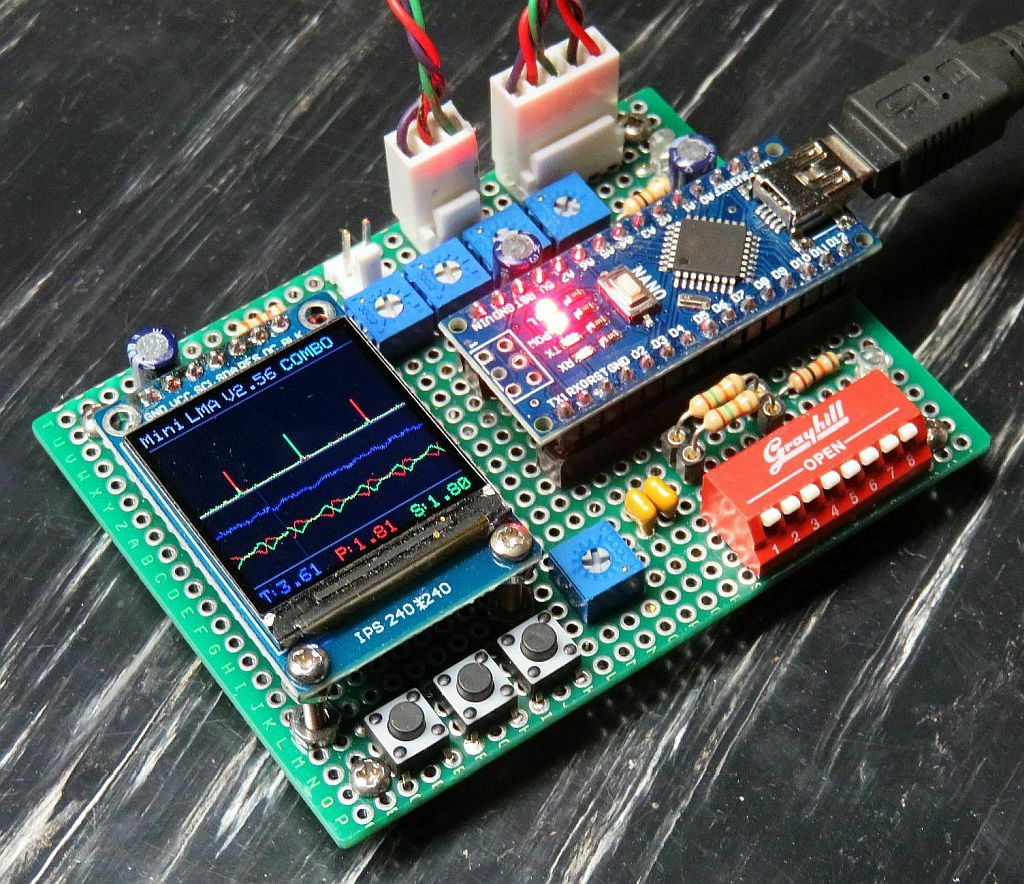
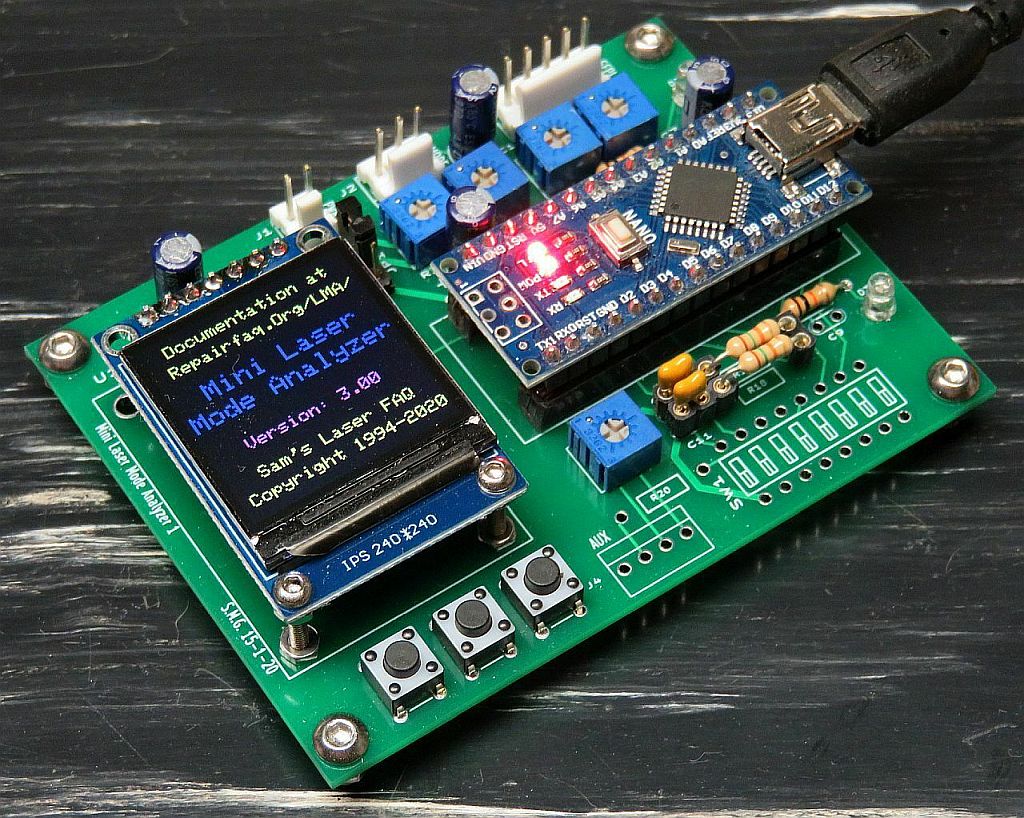
- mLMA1+Dual Pol MS Parts ONLY: mLMA1 electronics parts as above (with or without YOR
590-650 dual polarization for the SFPI) and also dual polarization mode
sampler parts adding a 45 degree sampler plate, 4x4x4 mm YOR 590-650 nm PBS cube, and 2 photodiodes. ONLY AVAILABLE FOR YOR 590-650 nm.
- Dual Pol Parts YOR 590-650 nm:
4x4x4 mm PBS cube for 590-650 nm and silicon photodiodes.
These may be used for the SFPI and mode display of the mLMA1. A closeup
of a completed dual polarization detector assembly on a Perf board is shown. But an SG-DET2 PCB with sockets for the PDs, protection resistor, bypass cap, and 4 pin screw terminal block is shown on the right constructed for side entry (top) or back entry (bottom) and the SG-DET2 or similar blank PCB is included.
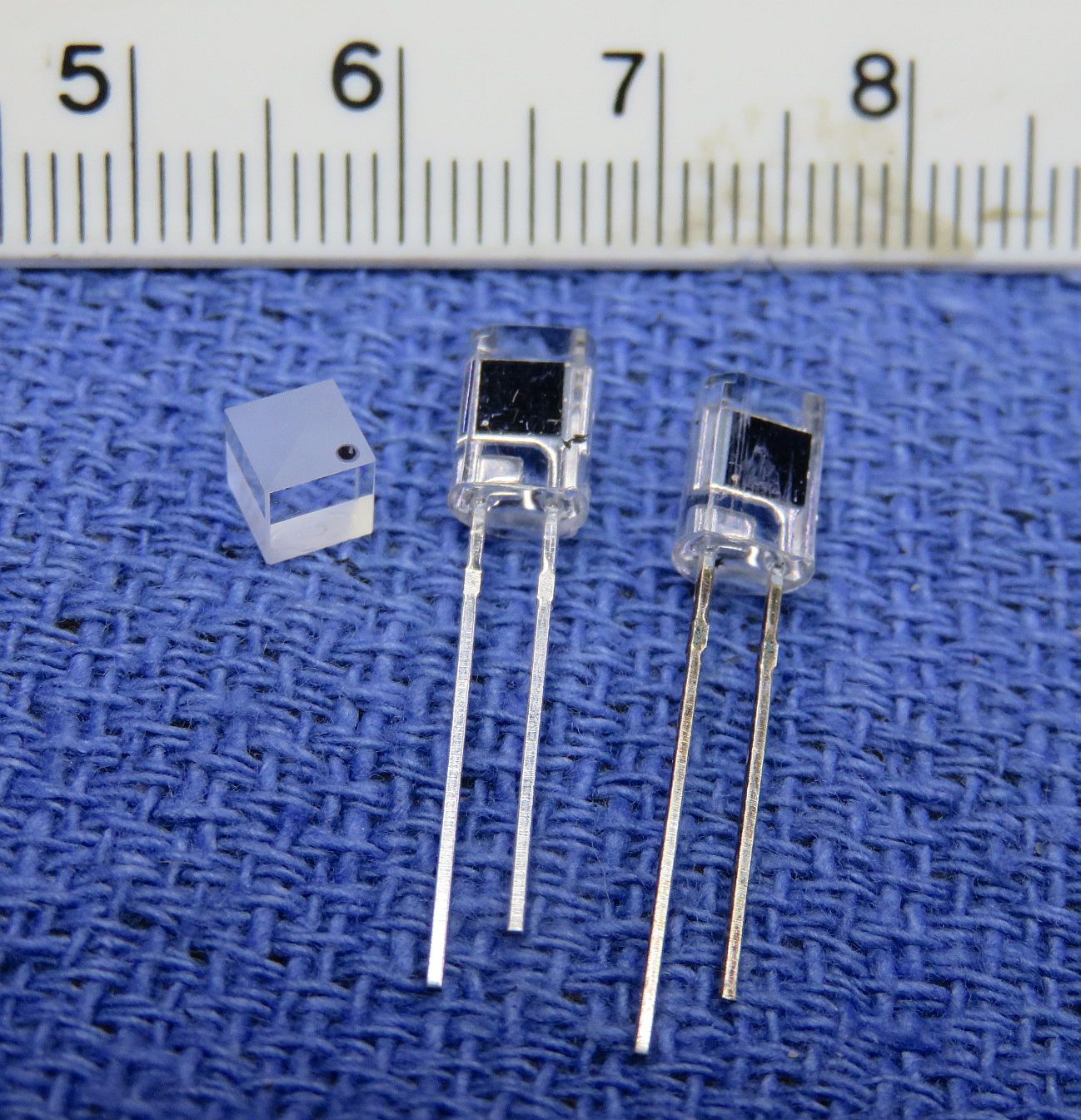
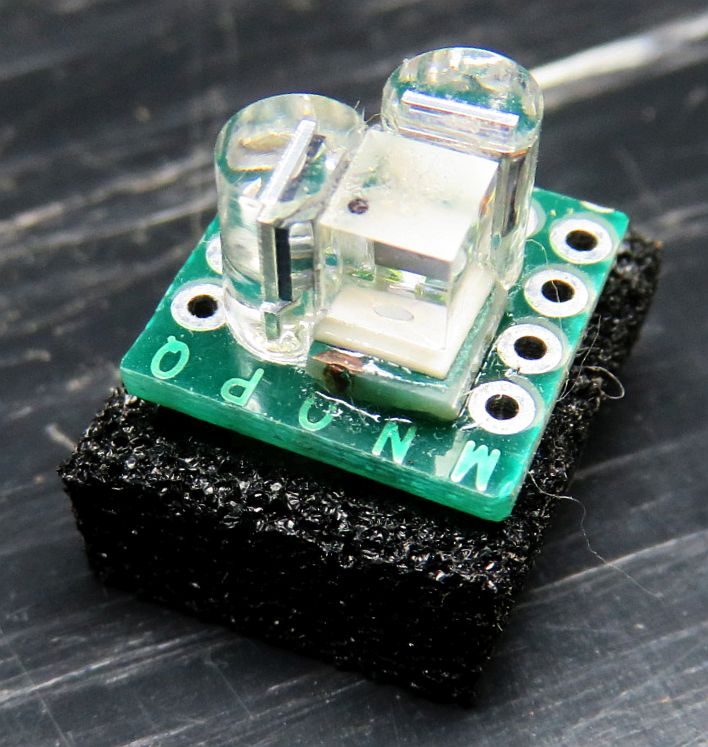

- Dual Pol Parts V 400-420 nm: 3x3x3 mm PBS cube for 400-420 nm, other parts similar to above.
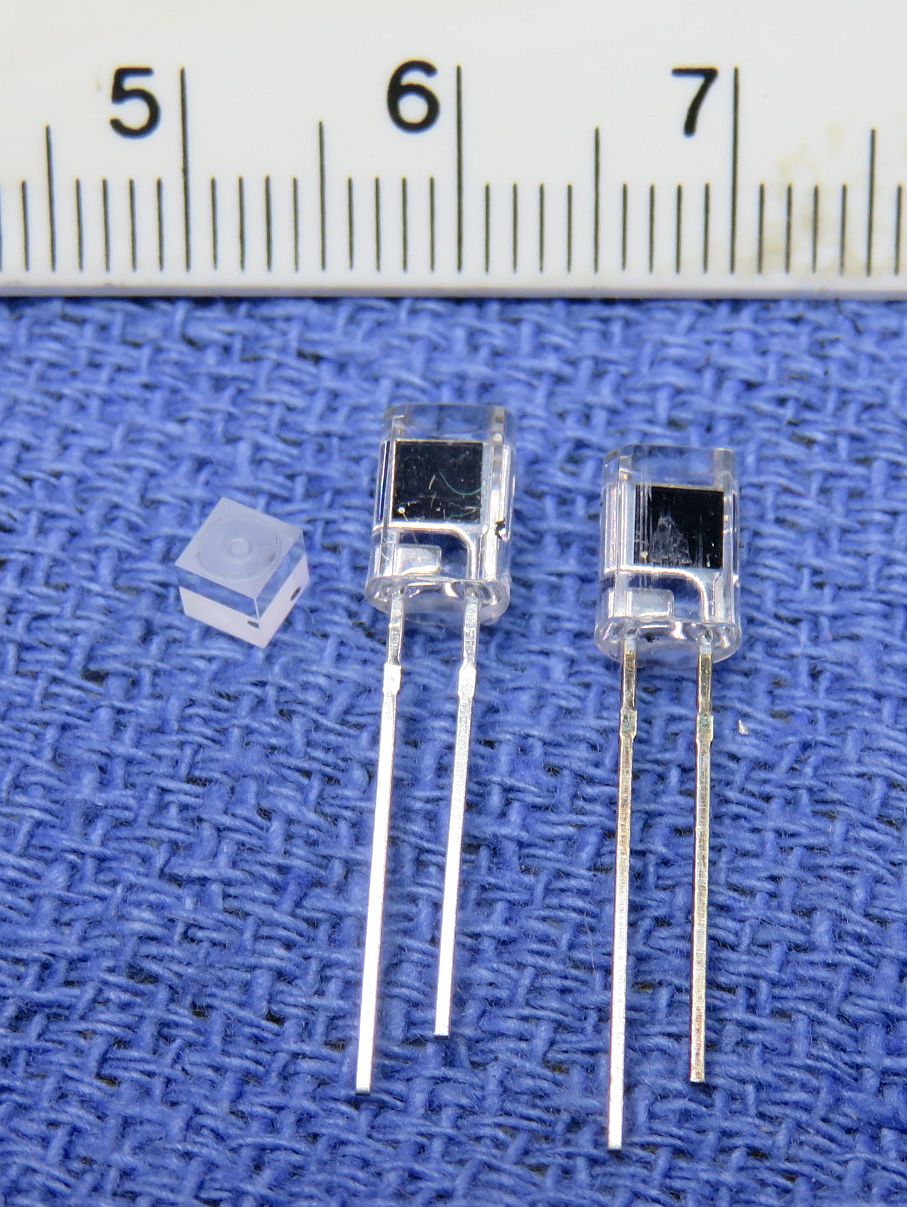
- PZT with Center Hole ONLY:
The same type of holey beeper "drum head" PZT used in all these SFPI
kits. The standard version is 27 mm in diameter with a 4-6 mm diameter
hole. Other diameters and hole sizes may be available. Those with a
larger diameter and/or smaller holes are more sensitive in terms of
V/FSR. Additional standard PZTs WITHOUT holes are also available at
$2.50 each.
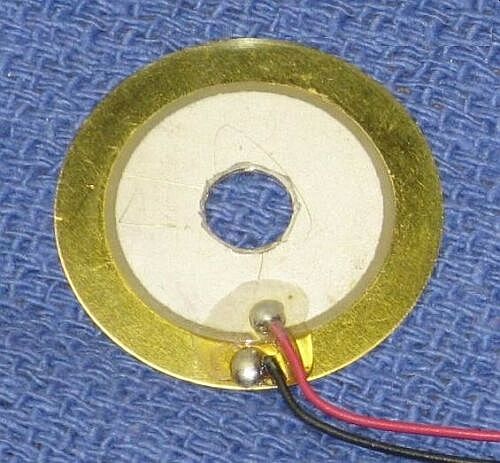
- mLMA1 BLANK PCB ONLY: All the parts are readily available and the firmware link is in the mLMA1 manual.
Additional information and options:
The
values for finesse are estimates except as noted but should be very
conservative. I've seen samples of the mirrors in SFPI Basic, Deluxe,
and Mini Deluxe kits YOR
590-650 nm providing a confocal finesse of over 500 at 633 nm with
careful mode matching and alignment. But your mileage may vary.
Confocal FSR is c/4L (c = speed of light, L= RoC) and confocal finesse
is approximately 3/[2(1-R)] for R close to 1 (100% reflectance). Planar
FSR is c/2L and planar finesse is approximately 3/(1-R). But for the
planar SFPI, alignment is super critical and when perfectly aligned,
there will be back-reflections directly into the laser, which may
destabilize it.
The dual polarization option adds:
- A small polarizing beam-splitter cube.
- A second photodiode.
This capability is useful primarily for 633 nm random polarized HeNes
where adjacent longitudinal modes are (usually) orthogonally polarized,
and being able to view them separately is desirable. This is a
capability that no commercial SFPI provides. ;-) The last photo shows a
dual SPFI display of a 5 mW random polarized HeNe laser that has
problems. If interested in this option for other kits where it's not an
option, ask. It will be the same cost but the only PBSs available
cover YOR 590-650 nm and V 400-420 nm.
The first (after the main photo) shows the typical 7.75 mm diameter
mirrors, PZT, and PD provided in all SPFI kits EXCEPT the Planar. The
mirrors are AR-coated on the other surface. The AR coating is optimum
at the specified wavelength(s) but should be satisfactory over a range
of values on either side. The mirrors shown are for the Basic, Deluxe,
and Deluxe-Mini SFPI YOR
590-650 nm kits. The mirrors for most of the others are of similar
size, though the curvature is not as pronounced and the color may
differ. Exceptions are mirrors for the Mid SFPIs (~10 mm diameter) and
Planar SFPIs (~7, ~12.7, or ~15 mm diameter depending on type).
The diagram shows the optical paths of a confocal SFPI. A typical SFPI
display of the longitudinal modes of a 5 mW red HeNe laser built using
the parts in the Basic, Deluxe, or Mini Deluxe kits is shown in the
forth graphic. Other graphics show the completed Deluxe-Mini SFPI YOR
590-650 nm assembly. The focusing lens is on the left, the input
mirror is in the center, and the output mirror on PZT is on the right.
The photodiode is hidden behind that mirror. Some mechanical skills and
assorted readily available materials will be required to construct the
SFPI, which will enable the longitudinal modes of most TEM00 red HeNe
lasers to be displayed in real time. These can also be configured with a
smaller mirror spacing which may have some benefits. For example, with
a mirrors at 1/2 the confocal spacing, while the finesse is slightly
lower, the FSR increases to 2.33 GHz.
Shorter implementations of the spherical mirror SFPIs like the "Hi-RES"
and "Long" SFPIs may be constructed that are more manageable in terms of
space and stability requirements with some sacrifice in finesse. In
the partial table below, the term d/r is 1 for the confocal spacing.
Where the mirror RoC is 1 meter as with the Hi Res SFPIs, d/r then
becomes the actual mirror spacing (though the actual RoC may differ from
the spec and your mileage may vary). Using a lower value will permit
the SFPI to be shorter, but the finesse also decreases. "Relative" is
with respect to the confocal spacing. Here are the first 10 spacings
which may be useful. There are also spacings that are longer than the
confocal which may be useful for the 4.2 cm RoC mirrors, more info
below.
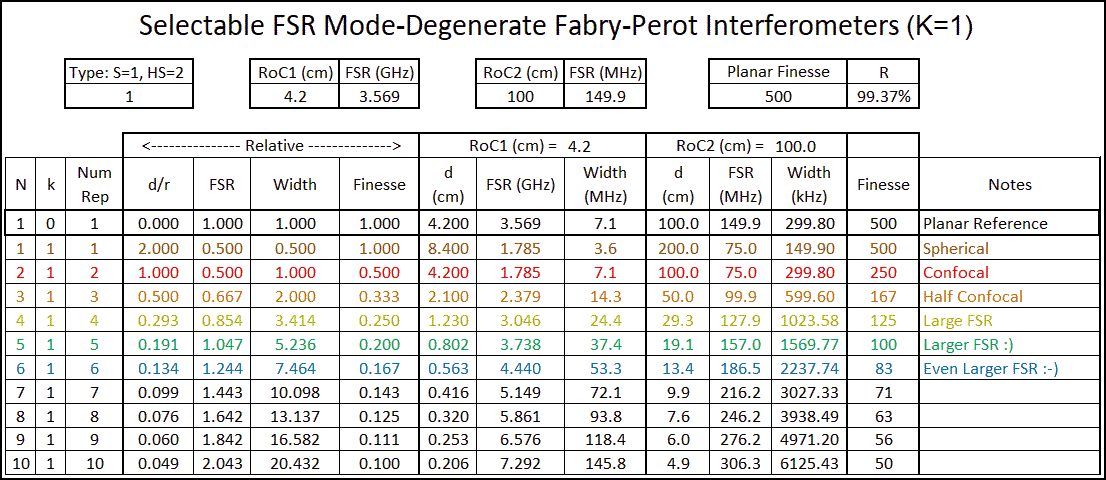
Two example mirror RoCs are shown: 4.2 cm applies to the Basic, Deluxe, and Deluxe-Mini YOR
590-650 nm SFPIs; 100 cm applies to the Hi Res and Deluxe and Deluxe+
Hi Res and Hi Res SFPIs (both wavelength ranges). N=2 is confocal.
N=3 is half-confocal with the advantage that it's FSR is 1/3rd larger
which is beneficial for 633 nm HeNe lasers where the lasing bandwidth is
1.5-1.6 GHz.
For more information, see "Sam's Laser FAQ, chapter on "Laser
Instruments and Applications", starting with "Scanning Fabry Perot
Interferometers". Google will find it.
The
mirror spacing for planar SFPIs is not restricted to specific values
and determines the finesse by c/2L (c = speed of light, L= mirror
spacing). However, as noted, aligning planar SFPIs is much more
challenging which is why planar SFPI kits include additional PZTs to be
arrange around the periphery of the "holely" PZT for fine alignment
which isn't essential but may make life easier. Using them will require
multiple variable voltage sources such as a 15 VDC power supply and
potentiometers wired as voltage dividers (not included).
An
electronic function generator with ramp or triangle waveforms may be
used as a driver, or one can easily be built. An oscilloscope (almost
any type) or data acquisition system (not included) will be required for
the display.
The photo of the scan of a ~5 mW red HeNe is typical of what to expect with the Basic, Deluxe, and Mini-Deluxe YOR 590-650 nm kits.
For the Basic, Mini, Micro, Nano, and Selectable FSR 590-650 nm kits
(Type 1-9), the Mini Laser Mode Analyzer (mLMA1) is an option to use in
place of the scope and function generator, at least to get you started,
though a real scope will still be better in the long run. mLMA1 is an
Arduino-based system which replaces the ramp driver/function generator
and oscilloscope. At present, it only provides basic functionality on a
small screen including SFPI, MODE, and POWER functions (including dual
polarization support with appropriate detectors in the head), but if you
don't have access to test equipment, this may be acceptable. All parts
are included except for a source of 5 V, which could be a USB port on a
PC, laptop, a USB charger, a 5 VDC power supply, or backup USB battery
(which has the lowest ripple and noise but may require an additional
load to not shut down). The photos show the prototype electronic
assembly displaying the modes of a short Zeeman HeNe laser tube and the
PCB version displaying the welcome screen. That's it. Really! Cool,
huh? ;-) The mLMA1 kit includes the PCB and all other electronic
components. The three-button interface/control panel is used to set
parameters. But the firmware is public and documentation is on-line. So
except for the PCB (which is quite simple), you can just do it on your
own at much lower cost. Tech support may be a wee bit less friendly
though. :) Search on the Web for "mLMA1 Mini Laser Mode Analyzer".
In my tests of one sample of the mirrors in SFPI YOR
590-650 nm kits, the reflectance was greater than 99.7% at 633 nm and
the confocal finesse exceeded 500 which may actually surpass the
performance of a $5,000 instrument. The finesse fell to around 250 at
594 nm (yellow HeNe), which is still quite exceptional. At 532 nm the
finesse is very low, but still might be adequate to determine if a green
laser is single longitudinal mode (single frequency) and suitable for
holography. At 655 nm, the reflectance appears to be even higher than at
633 nm, possibly 99.9% or more, though greater finesse may be limited
by other factors like coating losses and scatter. The reflectance is
still around 99% at 680 nm for a finesse of 150. The performance above
680 nm is not known at this time, but the finesse should still be decent
to 700 nm or more. However, I cannot guarantee that all mirrors will
achieve these high finesses and careful attention to alignment (both of
the mirrors in the SFPI frame and with respect to the laser) will be
critical so your mileage may vary.
The finesse using the blue mirrors isn't that high, but is probably
still sufficient to confirm single frequency/single longitudinal mode
(SLM) operation of a laser intended for holography or interferometry.
All parts are new or like new. The PZT has been modified by drilling a
hole in its center. And if that's all you want, buying just the
modified PZT is an option also. You may even specify the approximately
size of the desired hole. But the larger the hole, the lower the
sensitivity of the PZT to the driving voltage. The default is 4-6 mm.
If there is a configuration that isn't here using any of the mirrors in
this listing or any mirrors from my other listings, ask. For example,
if adjustable mounts at both ends of the Deluxe or Deluxe+ SFPIs would
be preferred, that can be arranged at just above the cost from Thorlabs
(currently around net $85 since one cage plate is no longer needed).
That's silly for the 4.3 cm RoC mirrors, but might make sense for the
longer ones, especially the HiRes versions, and simplify the
fabrication. Or leveling adjustments. Or longer or shorter cage rods.
Or if you want the highest finesse possible using a 1+ meter frame for
one of the Hi Res SFPIs, that can probably be arranged. ;-)
Much more information on SFPIs may be found in "Sam's Laser FAQ", chapter on "Laser Instruments and Applications". Construction guidelines specific to the parts in these kits may be found at "Sam's Electronics and Laser Kit Information and Manuals"
in the Laser FAQ table of contents. A search engine will find these
since eBay makes it impossible to provide useful information in
listings. And lifetime (yours or the SFPI) email tech support will be
provided.
The following options are also available (not covered by the selections above): - Set of adjustable front and
rear mounting plates cut to size and rough-finished (translation: may
be ugly), with adjustment screws
to attach to the Thorlabs KC1 and front cage plate for deluxe kits that
do not include them by default. These are typically around 4x3/4x3/8
and 2x3/4x3/8 inches and provide height adjustments when the SFPI head
is set on a table top. Not required if the SFPI head will be mounted in
some other way. $25 additional.
Iris diaphragm that screws onto front cage plate as an aid in alignment and minimizing back-reflections. $75 additional.
- Blank
ramp generator and preamp PCB: Up to 60 p-p triangle or sawtooth,
variable frequency, amplitude, and offset. Also includes variable gain
transimpedance photodiode preamp. A schematic and parts list will be
provided. Uses all common through-hole parts available from any
electronics distributor. The photo shows a completed sample. BLANK PCB
ONLY is $25 additional.
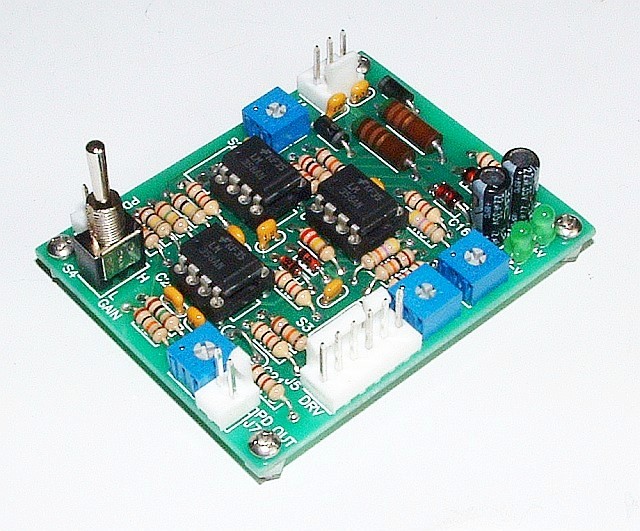
- Dual polarization blank PCB: This has a dual channel
trans-impedance variable gain preamp with other features useful for the
dual polarization option is also available but has NOT been fully
tested. The photo shows a populated PCB. BLANK PCB ONLY is $30
additional.
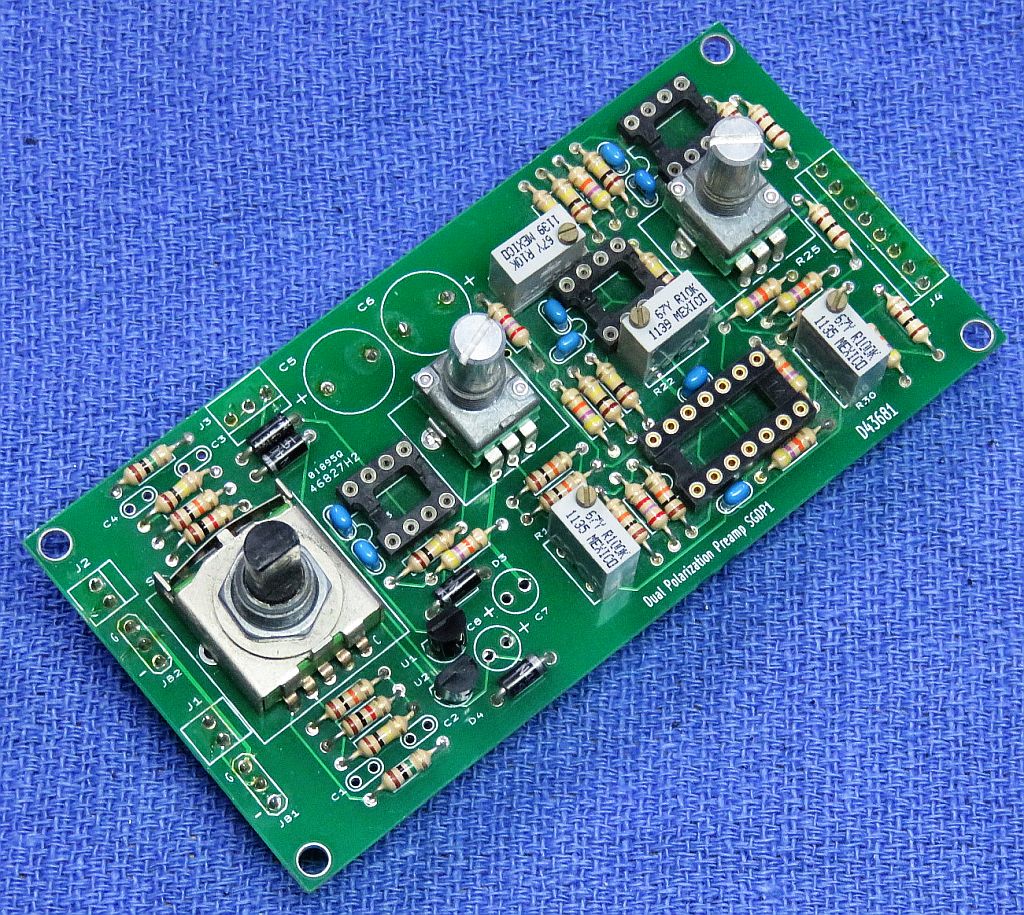
Inquire
for any of these or other options that may be available. SFPIs can be
configured with any suitable mirrors from my other listings or mirrors
of your own.
If
you have no idea what any of this stuff is, I can pretty much guarantee
you don't need one or a dozen. Although the mirrors do make decent
fish tank stones, there are much cheaper alternatives. ;-)
Due to the sensitivity of high quality laser cavity mirrors to abuse,
there will be a 20 percent restocking fee if returned for any reason
other than incorrect parts sent unless the sealed mirror package has not
been opened, sorry.
The non-Deluxe SFPI kits (mirrors, PZT, photodiodes) will generally ship
within 1 business day. But if Thorlabs parts need to be ordered for
the Deluxe versions, the shipping time will be longer.
Thanks for looking!
--- sam |
























